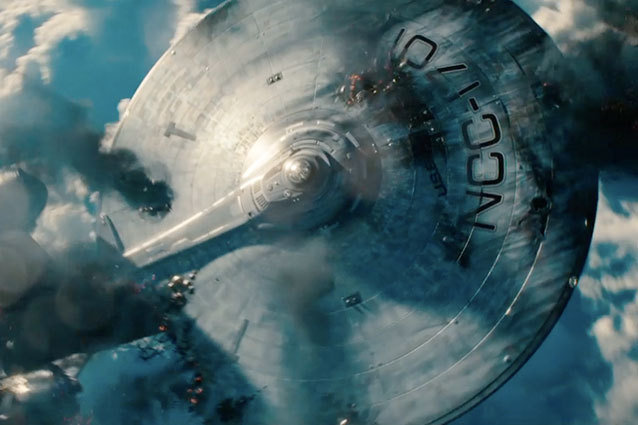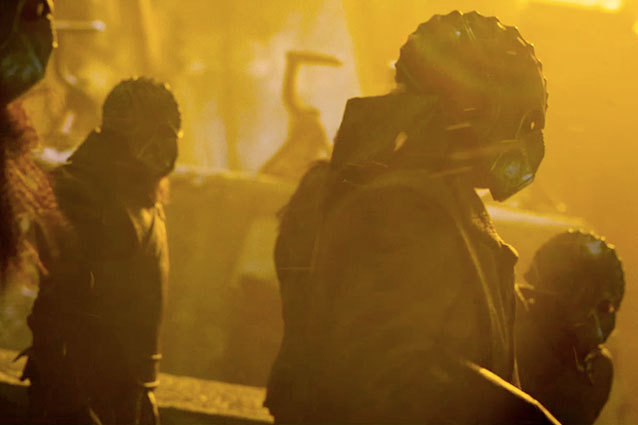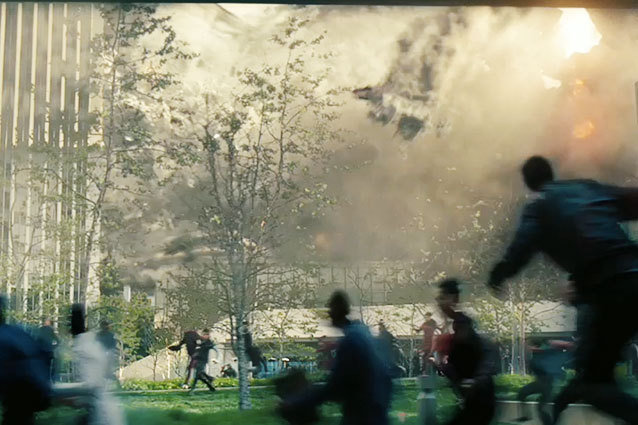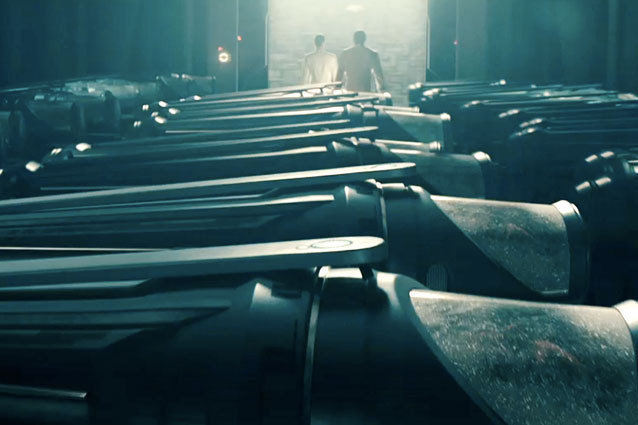
Star Trek Into Darkness is full of many mysteries: Are Tribbles contractually obligated to appear in all Star Trek movies from now on? Why does Carol Marcus have a British accent when she doesn’t have one in The Wrath of Khan and when her father Adm. Marcus (Peter Weller) is obviously all-American? Are we supposed to be okay with the destruction of much of San Francisco just because Kirk got over his self-doubt and landed his five-year mission? Did J.J. Abrams actually think Benedict Cumberbatch, as great as he is, could erase people’s memories of Ricardo Montalban? We can’t answer any of those. But the following eight burning questions we definitely can. Well, more or less.
1. Is the Enterprise Really Designed for Atmospheric Flight, Let Alone Underwater Travel?
As far as atmospheric flight is concerned, most definitely. Constitution-class starships are enabled for travel in planetary atmospheres, and the Enterprise does so on many occasions throughout The Original Series. Later versions of the Enterprise, like the Galaxy-class Enterprise-D from The Next Generation, would definitely not be able to do that, however. That said, there has never been any precedent for the Enterprise venturing underwater. I guess this altered timeline has resulted in even more modifications to the ship than we realized!
2. Is William Shatner’s Kirk Any More Responsible When It Comes to the Prime Directive?
Not really. Just check out the Original Series episode “The Apple,” in which Kirk is incredibly insistent that a group of primitive tribesman live free of the influence of an omnipotent god/minigolf obstacle called Vaal. He basically imposes “freedom” upon them, even though they’re not ready for it. And that’s not even counting Shatner Kirk’s 17 separate violations of the Temporal Prime Directive, according to Starfleet’s Temporal Investigations department in the 24th century. Those violations meant Kirk actually changed the timeline — like, say, bringing humpback whales 300 years into the future from 20th century Earth. Interestingly, Shatner Kirk never lost his command over any of those incidents, unlike Pine Kirk.
3. What Did Khan Do To Be Exiled in Space and Frozen for 300 Years?
Khan Noonien Singh and his followers were genetically engineered throughout central and south Asia in the 20th century to have superior physical and intellectual prowess. The scientists who bred them hoped that they would ascend to leadership positions in their respective countries — nations that had histories of conflict and poverty — and bring order from chaos. Well, most of them did become leaders. About 40 countries throughout Asia and the Middle East were under their control in the 1990s. But eventually the Augments, as they became known, turned on each other inaugurating a terrible conflict that lasted between 1992 and 1996 called the Eugenics Wars. Khan was the most powerful leader among these squabbling Augments and a cunning warrior — though it should be noted that none of the massacres and extermination campaigns led by the other Augment rulers occurred under Khan’s leadership. By 1996, all the Augment leaders had been defeated, and, facing certain death, Khan and 72 of his genetically-enhanced followers climbed aboard a spaceship he’d designed and christened the Botany Bay, after Australia’s famous 18th/19th century penal colony. It was a ship without warp drive so he and his followers had to enter cryosleep hoping that someday somebody would awaken them. That person was Kirk on The Original Series, and Admiral Marcus in Into Darkness.
4. Why Is There Such Hostility Between the Klingons and the Federation?

Humanity made a terrible impression upon the Klingon Empire upon their very first meeting in 2151 and won’t really be able to recover until the very end of the 23rd century. First contact between Earth and Qo’noS (in the film it’s styled Kronos) occurred when a Klingon warrior crash-landed in a farmer’s field in Broken Bow, Oklahoma, as seen in the pilot episode of Star Trek: Enterprise. The farmer wondered who this hulking, barking warrior was, so he shot him in the chest. An interstellar incident ensued and Capt. Jonathan Archer was tasked to return the injured Klingon to Kronos onboard the newly christened Enterprise NX-01 to avoid war. He succeeded, but the Klingons looked upon humanity with suspicion ever since. And after Earth entered into an interstellar Federation with the Vulcans, Tellarites, and Andorians, the gagh really hit the fan as far as the Klingons were concerned.
War was just a misstep away for decades and in 2259, the year of Star Trek Into Darkness, the cold war between the Federation and Kronos was at its peak. In the original timeline it was only in 2293, the year Shatner’s Kirk helped the Federation sign the Khitomer Accords with the Klingons, that peace was actually achieved. Will that still happen in J.J. Abrams alternate timeline?
5. What’s Up With That Shattered Moon Orbiting Kronos?
Presumably that’s the moon Praxis, where the Klingons conducted most of the geothermal energy harvesting to power their homeworld. In 2293 the moon blew apart due to overdrilling, an explosion that threatened even to render Kronos uninhabitable. That’s why the Klingons wanted to make peace with the Federation in the first place: they needed Starfleet’s help. Now, how come an event that didn’t occur until 2293 in the Prime Timeline appears to have already happened in 2259 in Abrams’ timeline? Well, because the Klingon Empire was greatly affected by Nero’s temporal incursion. In fact, years before he reassumed command of his vessel in order to hunt Spock and destroy Vulcan, Nero and his crew were captured by the Klingons. Then he escaped and obliterated a large Klingon fleet in the process. These events may have caused the already-warlike Klingons to become even more militaristic and mine Praxis that much more relentlessly for its precious energy. That could have caused it to blow up decades earlier than in the Prime Timeline.
6. Is the Destruction of San Francisco the Worst Tragedy to Befall Earth Since World War III?

Earth slowly but surely settled down following the conclusion of World War III in the mid-2050s. That conflict left 600 million dead, most of the world’s governments — and cities — destroyed and whole parts of the planet affected by nuclear winters for years. It was only with the adoption of the New United Nations in San Francisco that attempts to unify the planet into a United Earth government began in earnest, a process that was accelerated following first contact with Vulcan in 2063.
The next couple centuries are pretty quiet…with the exception of the Xindi Incident of 2153, as seen on Star Trek: Enterprise. Again, time travel was involved. The Xindi were a group of aliens who had been fed information from time travelers saying that humanity would one day hunt them to extinction. So the Xindi decided to strike against Earth first. They launched a probe to fire a particle weapon over what used to be the southern United States — obliterating much of Florida, in particular — and killed some 15 million people. That was more than a century before the events of Into Darkness, though, and few would probably be alive who’d have experienced it firsthand. Khan’s kamikaze piloting of the USS Vengeance into the heart of San Francisco probably didn’t kill as many people as the Xindi attack, but the psychological impact of such vast devastation in the Federation capital probably can’t be understated. J.J. Abrams & Co. wanted to incorporate an aspect of the War on Terror into their film, so they transformed Khan into a 9/11 hijacker with the USS Vengeance at his disposal instead of a 747.
7. How Can a Starfleet Admiral Be As Evil as Marcus?
With the exception of Admiral Pike (and, in the Prime Timeline, Admiral Kirk himself) Starfleet admirals are always evil! It’s an argument for absolute power corrupting absolutely because, because whether male or female, human or alien, they’re almost always trying to discredit our heroes, making power plays, or, like Admiral Marcus, trying to transform Starfleet into something more sinister.
8. Will the Federation Try to Manufacture Khan’s Super Blood?

You’d think they would, right? I mean, why else would they place Khan in cryofreeze once again? And it doesn’t seem like they’re putting him back aboard the Botany Bay for another decades or centuries-long space cruise. He seems to be going into cold storage in a warehouse somewhere. If his blood can actually extend people’s lives and even bring the recently deceased back to life, then Star Trek: Insurrection shows us the Federation will exploit that resource all it can — meaning that Cumberbatch’s Khan will be kept alive until he wakes up to wreak havoc in another film down the road.
Bonus Question: Why Is a Man Named “Khan Noonien Singh” a Pasty Englishman?
I’ve thought long and hard about it. I’ve ranted in thousands of words about it. But there’s still no good reason for it. Let the Star Trek Into Whiteness jokes commence!
Follow Christian Blauvelt on Twitter @Ctblauvelt and follow Hollywood.com @Hollywood_com
More:
We Rank All 79 Episodes of ‘Star Trek: The Original Series’ from Worst to Best
‘Star Trek Into Darkness’ Fan Review: Your ‘Star Wars’ Prequel Anger Is What I Feel Now
‘Star Trek Into Darkness’ Spoilers A Guide to Its Easter Eggs and Callbacks
From Our Partners Stars Pose Naked for ‘Allure’ (Celebuzz)
Stars Pose Naked for ‘Allure’ (Celebuzz) Which Game of Thrones Actor Looks Least Like His Character? (Vulture)
Which Game of Thrones Actor Looks Least Like His Character? (Vulture)


